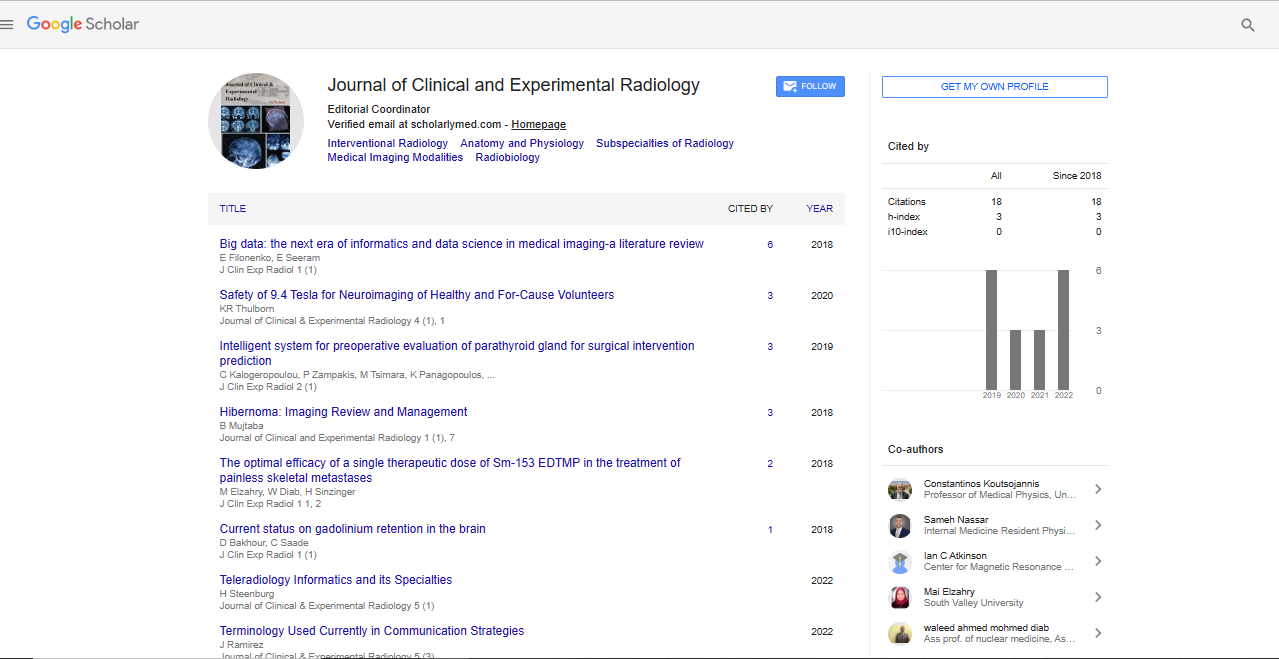Commentary, J Clin Exp Radiol Vol: 6 Issue: 4
Radiation Biology: Testament to the Interconnectedness of Scientific Disciplines
Hellning Keiane*
1Department of Radiation Oncology, Massachusetts General Hospital, Harvard Medical University, Boston, USA
*Corresponding Author: Hellning Keiane,
Department of Radiation Oncology,
Massachusetts General Hospital, Harvard Medical University, Boston, USA
E-mail: helkeiane@gmail.com
Received date: 24 November, 2023, Manuscript No. JCER-24-124148;
Editor assigned date: 28 November, 2023, PreQC No. JCER-24-124148 (PQ);
Reviewed date: 14 December, 2023, QC No. JCER-24-124148;
Revised date: 21 December, 2023, Manuscript No. JCER-24-124148 (R);
Published date: 28 December, 2023, DOI: 10.4172/jcer.1000156
Citation: Keiane H (2023) Radiation Biology: Testament to the Interconnectedness of Scientific Disciplines. J Clin Exp Radiol 6:4.
Description
Radiation biology, a multidisciplinary field at the crossroads of physics, chemistry, and biology, search into the intricate interactions between living organisms and ionizing radiation. This manuscript aims to resolve the complexities of radiation biology, exploring its fundamental principles, mechanisms of action, and implications for health and medicine.
Fundamentals of ionizing radiation
Interactions with matter: Ionizing radiation interacts with biological tissues primarily through two mechanisms-direct and indirect effects. Direct effects involve radiation interacting directly with cellular components, while indirect effects result from radiation interacting with water molecules, producing free radicals that, in turn, damage cellular structures.
Cellular response to radiation
Deoxyribonucleic Acid (DNA) damage and repair: One of the central themes in radiation biology is the impact of radiation on DNA. Ionizing radiation induces a spectrum of DNA damage, including single-strand breaks, double-strand breaks, and base damage. Cells have evolved intricate DNA repair mechanisms, such as nonhomologous end joining and homologous recombination, to rectify these insults.
Cell cycle checkpoints: Cells possess surveillance mechanisms known as cell cycle checkpoints that regulate progression through the cell cycle. Ionizing radiation activates these checkpoints, allowing cells to repair DNA damage before proceeding with cell division. Understanding these checkpoints is crucial for comprehending the fate of irradiated cells.
Biological effects of radiation
Deterministic vs. Stochastic effects: The biological effects of radiation can be broadly categorized into deterministic and stochastic effects. Deterministic effects, such as tissue damage and radiation sickness, have a threshold dose below which they do not occur. Stochastic effects, such as cancer induction, lack a threshold and are probabilistic, increasing with radiation dose.
Cancer as a stochastic effect: Perhaps the most significant longterm consequence of ionizing radiation exposure is the potential induction of cancer. Radiation can initiate genetic mutations and chromosomal aberrations, contributing to the multistep process of carcinogenesis. The stochastic nature of radiation-induced cancer underscores the importance of minimizing unnecessary radiation exposure.
Radiobiological models and concepts
Linear no-threshold model: The Linear No-Threshold (INT) model postulates that there is no safe threshold for radiation exposure, and any dose, no matter how small, carries some risk of harm. This model guides radiation protection guidelines and policies, emphasizing the need for minimizing radiation exposure in all contexts.
Relative Biological Effectiveness (RBE): Different types of radiation possess varying levels of biological effectiveness. RBE quantifies the relative potency of a given type of radiation compared to standard x-rays. Understanding RBE is essential for adjusting radiation doses in therapeutic applications like cancer radiotherapy.
Radioprotection and therapeutic applications
Radio protectors and radio sensitizers: Radio protectors are substances that mitigate the harmful effects of radiation on normal tissues, while radio sensitizers enhance the sensitivity of cancer cells to radiation. These agents play a crucial role in both radiation protection and therapeutic interventions, optimizing the balance between efficacy and side effects.
Radiation therapy: Radiation biology is foundational to the field of radiation therapy, a foundation in cancer treatment. Precise delivery of ionizing radiation to cancer cells exploits their inherent vulnerabilities, leading to cell death. Advances in radiation therapy techniques, such as intensity-modulated radiation therapy and stereotactic radiosurgery, showcase the evolving application of radiation biology principles in clinical settings.
Emerging frontiers and challenges
Radiation-induced bystander effects: Beyond the direct cellular response, radiation biology is uncovering the phenomenon of radiationinduced bystander effects. Non-irradiated cells neighboring irradiated cells can exhibit biological responses, broadening our understanding of the systemic impact of radiation exposure.
Genomic instability: Radiation-induced genomic instability refers to the long-term consequences of radiation exposure, including delayed genetic alterations in cells that were not directly irradiated. Unraveling the mechanisms behind genomic instability is a frontier that holds implications for cancer risk assessment and therapeutic strategies.
Conclusion
Radiation biology, with its intricate dance of molecular interactions and cellular responses, is at the forefront of shaping our understanding of ionizing radiation's impact on living organisms. From fundamental principles to therapeutic applications, the field continues to evolve, revealing new dimensions of complexity and offering avenues for both protective measures and innovative treatments. As we navigate the frontiers of radiation biology, the quest for knowledge persists-a journey marked by discovery, challenges, and the unwavering commitment to harnessing the power of radiation for the betterment of human health.
 Spanish
Spanish  Chinese
Chinese  Russian
Russian  German
German  French
French  Japanese
Japanese  Portuguese
Portuguese  Hindi
Hindi 